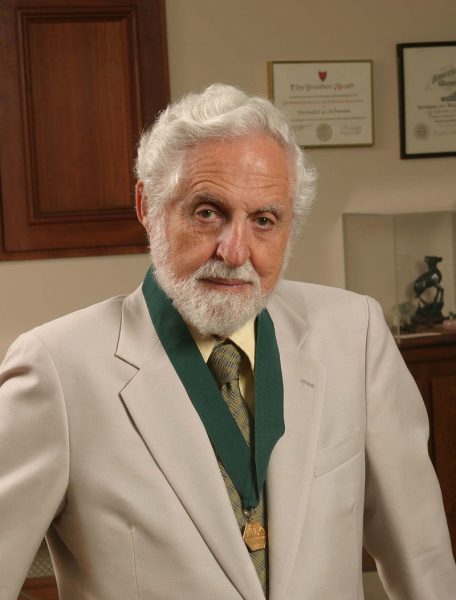
Carl Djerassi (1923-2015), photo: Science History Institute, CC BY-SA 3.0, via Wikimedia Commons
On 18 August, 1960, Enovid was launched as the first contraceptive pill in the United States. It was developed by Austrian-born Bulgarian-American chemist, novelist, and playwright Carl Djerassi. Furthermore, he is noted for establishing physical methods for determining organic molecular structure and his contributions to synthetic organic chemistry, his effectiveness in translating scientific knowledge into technological practice, and his efforts to promote international scientific cooperation.
Youth in Austria and Emigration to the USA
Carl Djerassi was born in Vienna, Austria, into a Jewish family and spent the first years of his infancy in Sofia, Bulgaria, the home of his father, Samuel Djerassi, a dermatologist and specialist in sexually transmitted diseases. His mother was Alice Friedmann, a Viennese dentist and physician. Until the age of 14, Djerassi attended the same realgymnasium that Sigmund Freud had attended many years earlier.
Austria refused him citizenship and after the Anschluss to the German Third Reich, his father briefly remarried his mother in 1938 to allow Carl and his mother to escape the Nazi regime and flee to Sofia, Bulgaria, where he lived with his father and attended the American College of Sofia. In 1939, together with his mother Djerassi arrived in the United States, where his mother worked in a group practice in upstate New York. In 1949, his father also emigrated to the United States.
Education and Career
Djerassi went on to take a degree in Chemistry at Kenyon College, Ohio and continued with postgraduate research at the University of Wisconsin, went on to take a degree in Chemistry at Kenyon College, Ohio. He continued with postgraduate research at the University of Wisconsin and became an American citizen in 1945 and became an American citizen. His thesis work examined the transformation of the male sex hormone testosterone into the female sex hormone estradiol, through a sequence of chemical reactions. His first job was as a junior chemist with the Swiss pharmaceutical company Ciba, in New Jersey, where he was part of the team credited with the discovery of the antihistamine pyribenzamine, used throughout the world to treat allergies.
Developing the Oral Contraceptive Pill
In 1949 Djerassi became associate director of research at Syntex in Mexico City and remained there through 1951. He worked on a new synthesis of cortisone based on diosgenin, a steroid sapogenin derived from a Mexican wild yam. His team later synthesized norethisterone (norethindrone), the first highly active progestin analogue that was effective when taken by mouth. This became part of one of the first successful combined oral contraceptive pills, known colloquially as the birth-control pill, or simply, the Pill.
From 1952–1959 Djerassi was professor of chemistry at Wayne State University in Detroit. Djerassi participated in the invention in 1951, together with Mexican Luis E. Miramontes and Hungarian-Mexican George Rosenkranz, of the progestin norethisterone — which, unlike progesterone, remained effective when taken orally and was far stronger than the naturally occurring hormone. His preparation was first administered as an oral contraceptive to animals by Gregory Goodwin Pincus and Min Chueh Chang and to women by John Rock.
In 1960 Djerassi became a professor of chemistry at Stanford University, a position he held until 2002. From 1968 until 1972 he also served as president of Syntex Research at Palo Alto.

Different kinds of birth control pills. photo: Ceridwen, CC BY-SA 2.0 FR, via Wikimedia Commons
Collecting Art and Pioneering Physical Research Technologies
The Syntex connection brought wealth to Djerassi. Besides building up a large cattle ranch, he also assembled a large art collection. His collection of works by Paul Klee was considered to be one of the most significant to be privately held. Throughout the 1960s and 1970s, Djerassi pioneered novel physical research techniques for mass spectrometry and optical rotatory dispersion and applied them to the areas of organic chemistry and the life sciences. Focusing on the steroid hormones and alkaloids, he elucidated the structure of steroids, an area in which he published over 1,200 papers. His scientific interests were wide-ranging, and his technological achievements include work in instrumentation, pharmaceuticals, insect control, the application of artificial intelligence in biomedical research, and the biology and chemistry of marine organisms.
From Birth Control to Pest Control
In 1968, he started a new company, Zoecon, which focused on environmentally soft methods of pest control, using modified insect growth hormones to stop insects from metamorphosing from the larval stage to the pupal and adult stages. Zoecon was later sold it to Sandoz, now Novartis. In 1965 at Stanford University, nobel laureate Joshua Lederberg, computer scientist Edward Feigenbaum, and Djerassi devised the computer program DENDRAL (dendritic algorithm) for the elucidation of the molecular structure of unknown organic compounds taken from known groups of such compounds, such as the alkaloids and the steroids. This was a prototype for expert systems and one of the first uses of artificial intelligence in biomedical research.
Writing
Djerassi wrote five novels, four of which he describes as “science-in-fiction”, fiction which portrays the lives of real scientists, with all their accomplishments, conflicts, and aspirations. The genre is also referred to as Lab lit. In his first two novels, Cantor’s Dilemma and Bourbaki Gambit, he shows how scientists work and think. In Cantor’s Dilemma, there is the suspicion of scientific fraud; in Bourbaki Gambit the question of personal achievement stands in the center. After his success with prose literature in the Science-in-Fiction genre, Carl Djerassi started to write plays. Djerassi’s first play, An Immaculate Misconception (1998), dealing with the in vitro fertilization procedure ICSI, was followed by two plays about priority struggles in the history of science, Oxygen (co-authored with Roald Hoffmann, 1999) and Calculus (2002), and a drama at the intersection of chemistry and art history, Phallacy (2004). Djerassi wrote numerous poems that were published in journals or anthologies.
Carl Djerassi died on January 30, 2015 at the age of 91.
Overpopulation facts – the problem no one will discuss: Alexandra Paul at TEDxTopanga, [7]
References and Further Reading:
- [1] Robert D. MacFadden, Carl Djerassi, 91, a Creator of the Birth Control Pill, Dies, NY Times, January 31, 2015.
- [2] Gregory Pincus and the Contraceptive Pill, SciHi blog, April 8, 2016.
- [3] The Contraceptive Pill – One of the Most Influential Inventions of the 20th Century, SciHi blog, August 18, 2013.
- [4] Carl Djerassi, father of the Pill – obituary, The Telegraph, Obituary, Feb 2, 2015.
- [5] Carl Djerassi: Meeting strangers and three autobiographies, Video interview with Carl Djerassi.
- [6] Carl Djerassi at Wikidata
- [7] Overpopulation facts – the problem no one will discuss: Alexandra Paul at TEDxTopanga, 2013, TEDx Talks
- [8] Carl Djerassi Timeline via Wikidata





